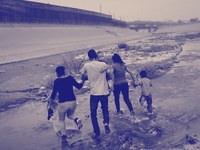
The past two weeks has seen a surge in reporting on how U.S. Customs and Border Protection treats immigrants as they enter the country. On Monday, July 1st, lawmakers toured border-patrol facilities in El Paso and Clint, Texas, and spoke with women who were detained there. The women recounted that their children had been taken from them; they were being held in cramped cells with little access to fresh water and had been told to drink from the toilet. That day, ProPublica reported on a secret Facebook group for Border Patrol agents, with nearly ten thousand members, who posted vulgar insults of immigrants and of the lawmakers who visited them in Texas. On Sunday, the New York Times and the El Paso Times published an investigation into the Border Patrol facility in Clint, where hundreds of children, many of them separated from family members, have been held in unsanitary, cruel, and overcrowded conditions. In response, the Trump Administration claimed that the border-patrol facilities were adequate, and President Trump called the Times piece a “hoax.”
In order to place this ongoing crisis into a broader international and historical context, I recently spoke by phone with Michael Garcia Bochenek, who is the senior counsel to the Children’s Rights division of Human Rights Watch. Bochenek, who previously served as the director of law and policy for Amnesty International’s London secretariat, has extensive experience visiting child detainees in the United States and around the world. During our conversation, which has been edited for length and clarity, we discussed what he learned from seeing detained children abroad, the attitudes of guards at border facilities, and why America makes it so difficult for human-rights advocates to visit detained children.
As this largely self-imposed humanitarian crisis has been developing on the border, what have you made of the images and reports you have been seeing, especially given your international experience?
“Self-imposed” is really the right word, not only in terms of a manufactured emergency. This is something that, numerically speaking, isn’t very unusual, something that in terms of capacity isn’t that much of a challenge, in a country with considerable resources. Anytime we are looking at deficiencies in terms of conditions of detention, lack of access to needed programming, lack of attention to mental-health and other health services—the cause of that is not that there is not money, or there is no capacity, or there is no expertise, as has been the case in some places that I have been. It’s a policy choice. It’s a choice to inflict these kinds of conditions on people, and in this case on children.
Can you discuss those other detention centers that you have seen around the world, where the conditions stem from a lack of expertise, or the country is overwhelmed?
The closest contexts that I can think of are primarily in the juvenile and criminal settings. These are kids, and sometimes adults, who are charged with crimes or convicted of crimes and who are going through a criminal process as opposed to an administrative immigration situation. For example, kids held in Brazil, or kids held in many other Latin American countries, are often held in overcrowded conditions. There is often a severe lack of access to necessary health care. Sometimes the quality of food is an issue. Rarely, in the case of Brazil, are education or other kinds of activities wholly unavailable, although sometimes there is a significant gender difference in terms of who gets offered what. Boys might get access to sporting activities, and girls are expected to sit quietly and do needlework. There are problems in that regard.
But, significantly, it’s not really a question, in a place like Brazil, that kids should have access to education. The question that often arises there is what curriculum should they follow, given that people are coming in and out all the time. In the United States, in contrast, particularly with these immigration holding cells, there’s absolutely no pretense of offering education. Even though, in some cases, we’re talking about having kids for weeks. If there are standards with relation to activities, they’re certainly observed in the breach.
In terms of caring for detained kids, is this something that democratic countries have always been much better about? Or is that distinction not helpful?
I think the answer to that probably has less to do with the form of government and more to do with other decisions. European Union countries have very few kids in detention, whether that’s juvenile justice or immigration detention, as compared to the United States. The United States is kind of a standout in the world, in the worst sense possible, around detention. When European countries do detain kids, they often do so with lots of support services.
In fact, at one point, I taught children’s rights at Georgetown Law School, and I took the law students, who were both U.S. students and foreign students, into the D.C. juvenile-detention center. A lot of the students from countries other than Europe were shocked by how clean U.S. facilities were. The U.S. students were appalled at the conditions. And the European students couldn’t believe what they were seeing. For the European students, particularly those from Scandinavia, Germany, Holland, and so on, what they were used to from their home countries was a far more nurturing environment than what they were seeing in this institutional setting that could well have been, in their mind, an adult correctional facility. Possibly for very, very serious offenders.
So are you saying democratic traditions and values do matter, just not in the United States?
If you ask me to contrast countries that most people would describe as democratic, those are the two obvious ends of the spectrum that come to mind. But—just to name a few places where I’ve gone into detention centers—Angola, Liberia, Brazil, Mexico, and Guatemala have significant degrees of repression, or certainly have targeted people for speaking out. Including kids. But, in all of those places, there’s some recognition that kids should be held in a way that is consistent with furthering their development. There is the idea of offering them rehabilitation, the idea of giving them a second chance, even if, in practice, that isn’t available because of the conditions in which they’re held. What is often lacking is the wherewithal to carry that out.
In many of the countries that I’ve been to, they have infrastructure that’s falling apart, staff that is going unpaid for periods of time—again, largely, it seems, because of resources. And there is an effort in some of these places to put real limits on the time that kids are held. So kids in Liberia, when I was there—very, very few of them are locked up, for very little time, even though in the adult system it was very common for people to be held without charge for the maximum time that was permitted.
I was going to say, one irony of this, if it’s an irony, is that it takes incredible resources to lock these kids up.
It takes a lot of money to do this. We’re talking about seven hundred and fifty to seven hundred and seventy-five dollars per day, per child. That’s a lot of money that could be used to do something else. We know that the other options—such as to place them with other family members, in foster-care facilities, in child facilities that are, in fact, living up to court orders or U.S. government settlement agreements—are cheaper.
What have you made of the debate about the term “concentration camp”?
It’s obviously generated a lot of heated discussions. For my part, for Human Rights Watch, we’re trying to focus on the largely undisputed conditions in which kids are being held. The standards, including the Border Control’s own standards, are going disregarded. We’re talking about severe overcrowding, kids being held for days without regular access to showers, not being able to brush their teeth every day, and maybe not at all in the time that they’ve been there. Family separation—not just parent-child separation but also separation from older siblings, from uncles, grandmothers. None of this is humane in the slightest. This is the kind of degrading, cruel treatment that is unnecessary. It’s difficult to think what it was designed for other than to punish. I think these facts are what we should be focussing on.
MORE FROM
Tell me a little bit about your work. No. 1, why are you let into certain facilities abroad, and, two, what does a visit of yours consist of?
We’ll request access to the facilities well in advance. There’s no requirement on the part of countries to let us in. It’s all about negotiation. The visits I’ve been doing of Border Patrol stations and these Health and Human Services shelters are different, because there is a court order that allows access to lawyers and other experts who are monitoring compliance with the Flores agreement.
But, in general, what we’re doing is having to negotiate with different governments. I’ve never had that access denied anywhere in the world. And it will often take a bit of back-and-forth about the purpose of the visit. But, in my experience, when Human Rights Watch or Amnesty International request access to places of detention, we get it.
The governments give us this access because in many countries there is an affirmative respect for the principle that there should be monitoring of places of detention by people other than the government. And, in other cases, where there isn’t necessarily an existing policy decision, there’s some recognition that it would look worse for them to deny access than to give us access.
There are places where access, over all, is curtailed. But wherever I’ve asked for access to detention facilities for kids or for adults, for criminal justice or immigration, I’ve got it. The United States is the most difficult place to get access to. It once took me eleven months to get access to the Baltimore city jail.
What did you find when you got access?
A lot of kids locked up in really small places, for really extended portions of the day. This was more than a decade ago. The city jail was primarily for adults, but it had one wing for kids who were accused of juvenile offenses. Because they had to be separated by sight and sound from the adult detainees, they were there for twenty-three or twenty-three and a half hours a day.
Have you been down to the border this past month?
I’ve been in El Paso, in June. I was at the Tornillo tent facility before it closed, at the end of 2018. We did Homestead in March, not on the border but relevant because a lot of the kids who are entering, and spend time in these C.B.P. holding cells, are then flown to Homestead.
Is there some aspect of the reporting on this or the conversation about it that you feel has not got out, or has not been discussed enough?
It’s utterly mystifying to people that I speak with what the difference is between these different kinds of facilities. Why is it that kids are in Border Patrol stations at all, given that border agents themselves tell me and my colleagues pretty frankly that they’re not equipped for this population? Kids shouldn’t be there for any length of time, much less the time that they are. This is something that, in different ways, people are really focussing on in the various stories that are being published. The real question that is precisely the right one is: Why are they in the holding cells at all? Why not quickly move them to more appropriate accommodations? There’s no good answer to that. It’s not as though the U.S. has no capacity to do that. We know that Health and Human Services can, if it wants to, when it needs to, expedite the family-clearance process, the process of vetting family members to make sure there’s no danger to send the children to them. Because they did that last summer, with regard to litigation around family separation. And we know that there are readily available alternatives for kids who come with their families. So why you would need anything more than a couple of hours in a holding cell is the real mystery.
What was your impression of the guards and lower-level people at these facilities?
It really varies, but the agents that I’ve spoken with are falling into three basic groups. One is those who are really moved by what they’re seeing, and who are spending their own money on extra things, like lollipops, that they want to bring in for the kids. Probably not the most healthy choices, but it’s something that they’re doing, trying to show the kids some level of comfort. Or they are taking time out to make sure the kids are O.K. That is humbling. It’s heartening because I think it’s easy, in this kind of setting, to lose sight of the human beings that you’re dealing with.
The second group is probably more numerous, unfortunately, which is the people who tell themselves, “I have a job to do. I’m following orders. I’m just going to look straight ahead and not acknowledge that I’ve got five-year-olds in the cell to the left of me. And I’ve got a two-year-old in the cell to the right who probably should be in diapers, but maybe the eight-year-old who was caring for him doesn’t know that and does not have access to them. But I’m going to just do my job.”
Then there’s the third group, which hopefully is quite small—but when I’m walking down the hallway in the back office of Clint or somewhere else, sometimes the doors are open, and I’m looking in and I’m seeing insignias on the wall that are sort of paramilitary in character. I’m getting a gung-ho read from what agents are saying to each other, when they don’t realize I speak Spanish or realize I’m in earshot. Or when they’re talking to me directly, and they’re treating this operation, which is really unlike anything they were hired to do, as if locking up small children in tiny cages is a vital national-security matter.
Are you hinting that there are some nationalistic or bigoted views? Or am I reading too much into that?
If we’re talking on the same order as some of the things in Hungary, or some other places where there is a real vehement appeal to nationalism, that’s not what I’m referring to. There is a lot of flag-waving by everybody. And people can be patriotic without being abusive. And should be, right? Should honor their country, honor their flag, without being abusive.
The racism, on the other hand . . . I think agents are more careful around me and around my colleagues. But they’re much less careful around the people that they have custody of. There are accounts, from kids and from adults, of being referred to in really racially derogatory ways. These are obviously secondhand accounts, but they’re consistent, they’re numerous, they’re spread out over time, and they predate the past year. The same kind of language comes through in the secret Facebook Border Patrol postings.
Are these the same three groups, broadly speaking, that you’ve found when you’ve been at places abroad? Or is there something unique or different about what you’re seeing at these border facilities in America in 2019?
I guess what is slightly different is that I’m seeing a larger number of people that are affected by what they’re being forced to do. And in that I include both those who are going out of their way to show some compassion and those who are behaving in a more robotic way.
I would suggest that they’re actually quite traumatized by these kinds of practices. And, on the other hand, what has always been the case in other facilities in other contexts, in other countries in particular, to a far greater degree than here, is that guards, or other staff, get that what we’re doing is going to help them do their job, and go out of their way to tell us where we should be looking. We had some of that from border agents in some of these facilities, but I think the connection between human-rights monitoring and better working conditions is far more apparent to the average prison guard in a place like Nigeria or Brazil than it seems to be in Texas.




